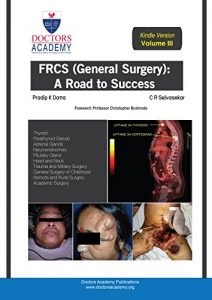This is the third of the four volumes in the Kindle edition of the highly popular book ‘FRCS General Surgery: A Road to Success’. The third volume contains the following chapters:
•Thyroid
•Parathyroid Glands
•Adrenal Glands Neuroendocrines
•Pituitary Gland
•Head and Neck
•Trauma and Military Surgery
•General Surgery of Childhood
•Remote and Rural Surgery
•Academic Surgery
The four volumes together are essentially the product of hand-outs given to postgraduates attending courses for well over 30 years conducted by one of the authors (PKD) for the old style FRCS, the current Exit FRCS and MRCS examinations. This is primarily meant for the trainee surgeon sitting the Exit FRCS in the UK and abroad.
How to benefit the most from this book?
Each chapter commences with a short synopsis followed by a list of diagnoses. This is followed by a number of clinical scenarios. Following this, the answers are structured in the form of ‘Diagnosis matched with clinical features and images’. After the answer to each question is provided [i.e., the diagnosis that matches the clinical scenario], a clinical or radiological image is usually shown. This is followed by a set of questions and detailed answers [explanations]. The questions and answers will flow in the format of a viva-voce. If one considers this layout from an exam perspective, you will appreciate that the viva usually starts with a clinical scenario where you would be expected to make a correct diagnosis, followed by management of the patient. The management section will comprise of questions related to clinical presentation, diagnostic criteria, pathophysiology of the condition, guidelines to follow, appropriate investigations and treatment options including surgery. The book will thus enable to approach each topic in the format one will be tested in the exam. The detailed chapter on applied physiology and critical care [and another on management of pain] in Volume 4 will provide the user with a sound understanding of the fundamental principles in managing a critically ill surgical patient.
•Thyroid
•Parathyroid Glands
•Adrenal Glands Neuroendocrines
•Pituitary Gland
•Head and Neck
•Trauma and Military Surgery
•General Surgery of Childhood
•Remote and Rural Surgery
•Academic Surgery
The four volumes together are essentially the product of hand-outs given to postgraduates attending courses for well over 30 years conducted by one of the authors (PKD) for the old style FRCS, the current Exit FRCS and MRCS examinations. This is primarily meant for the trainee surgeon sitting the Exit FRCS in the UK and abroad.
How to benefit the most from this book?
Each chapter commences with a short synopsis followed by a list of diagnoses. This is followed by a number of clinical scenarios. Following this, the answers are structured in the form of ‘Diagnosis matched with clinical features and images’. After the answer to each question is provided [i.e., the diagnosis that matches the clinical scenario], a clinical or radiological image is usually shown. This is followed by a set of questions and detailed answers [explanations]. The questions and answers will flow in the format of a viva-voce. If one considers this layout from an exam perspective, you will appreciate that the viva usually starts with a clinical scenario where you would be expected to make a correct diagnosis, followed by management of the patient. The management section will comprise of questions related to clinical presentation, diagnostic criteria, pathophysiology of the condition, guidelines to follow, appropriate investigations and treatment options including surgery. The book will thus enable to approach each topic in the format one will be tested in the exam. The detailed chapter on applied physiology and critical care [and another on management of pain] in Volume 4 will provide the user with a sound understanding of the fundamental principles in managing a critically ill surgical patient.






